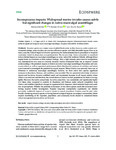Inconspicuous impacts: Widespread marine invader causes subtle but significant changes in native macroalgal assemblages
| dc.contributor.author | Epstein, G | |
| dc.contributor.author | Foggo, Andrew | |
| dc.contributor.author | Smale, DA | |
| dc.date.accessioned | 2019-08-06T11:04:48Z | |
| dc.date.available | 2019-08-06T11:04:48Z | |
| dc.date.issued | 2019-07 | |
| dc.identifier.issn | 2150-8925 | |
| dc.identifier.issn | 2150-8925 | |
| dc.identifier.other | ARTN e02814 | |
| dc.identifier.uri | http://hdl.handle.net/10026.1/14755 | |
| dc.description.abstract |
<jats:title>Abstract</jats:title><jats:p>Invasive species are a major cause of global biodiversity decline; however, under certain environmental settings, some invaders can co‐exist with native species with little detectable impact. Even so, in many cases the realized impact of invasive species may be underestimated due to procedural or temporal constraints related to observation or experimentation. The invasive kelp, <jats:italic>Undaria pinnatifida</jats:italic>, is considered to have limited impact on macroalgal assemblages on rocky reefs of the northeast Atlantic, although this is largely based on correlative or observational findings. Here, a high intensity press‐removal manipulation was maintained for two years at a heavily invaded, <jats:italic>Undaria</jats:italic> dominated study site to improve current understanding of the potential impacts of <jats:italic>Undaria</jats:italic> on native macroalgal assemblages. Population and community effects as well as organismal performance effects (biochemical measures of condition and stress) were examined to investigate the potential for cryptic impacts. Where <jats:italic>Undaria</jats:italic> was removed, there was no difference in understory macroalgal assemblages; however, for three native kelp species, significant increases in abundance, biomass, and condition were recorded. The two perennial native kelps (<jats:italic>Laminaria digitata</jats:italic> and <jats:italic>Saccharina latissima</jats:italic>) exhibited small and inconsistent increases in all impact metrics where <jats:italic>Undaria</jats:italic> was removed, and therefore, the overall effects of <jats:italic>Undaria</jats:italic> on their populations are likely to be negligible. However, the native annual kelp, <jats:italic>Saccorhiza polyschides,</jats:italic> was consistently and significantly higher (3–6 times when compared to controls) in abundance and biomass under reduced competition from <jats:italic>Undaria</jats:italic> and exhibited significant changes in organismal‐level responses which indicated improved condition of sporophytes. Whether the potential replacement of this native species could alter ecosystem functioning requires further investigation. Targeted long‐term manipulative experiments can identify previously undetected impacts of invasive species in coastal ecosystems. Caution must be used when broadly classifying invasive species as having limited ecological impacts on recipient communities. Subtle impacts manifesting at the organism, population, and community levels should be considered before robust management prioritizations can be made.</jats:p> | |
| dc.language | en | |
| dc.language.iso | en | |
| dc.publisher | Ecological Society of America | |
| dc.subject | impact | |
| dc.subject | invasion ecology | |
| dc.subject | invasive | |
| dc.subject | kelp | |
| dc.subject | macroalgae | |
| dc.subject | non-native | |
| dc.subject | Undaria pinnatifida | |
| dc.title | Inconspicuous impacts: Widespread marine invader causes subtle but significant changes in native macroalgal assemblages | |
| dc.type | journal-article | |
| dc.type | Journal Article | |
| plymouth.author-url | https://www.webofscience.com/api/gateway?GWVersion=2&SrcApp=PARTNER_APP&SrcAuth=LinksAMR&KeyUT=WOS:000477912900022&DestLinkType=FullRecord&DestApp=ALL_WOS&UsrCustomerID=11bb513d99f797142bcfeffcc58ea008 | |
| plymouth.issue | 7 | |
| plymouth.volume | 10 | |
| plymouth.publication-status | Published | |
| plymouth.journal | Ecosphere | |
| dc.identifier.doi | 10.1002/ecs2.2814 | |
| plymouth.organisational-group | /Plymouth | |
| plymouth.organisational-group | /Plymouth/Faculty of Science and Engineering | |
| plymouth.organisational-group | /Plymouth/Faculty of Science and Engineering/School of Biological and Marine Sciences | |
| plymouth.organisational-group | /Plymouth/REF 2021 Researchers by UoA | |
| plymouth.organisational-group | /Plymouth/REF 2021 Researchers by UoA/UoA07 Earth Systems and Environmental Sciences | |
| plymouth.organisational-group | /Plymouth/Research Groups | |
| plymouth.organisational-group | /Plymouth/Research Groups/Marine Institute | |
| plymouth.organisational-group | /Plymouth/Users by role | |
| plymouth.organisational-group | /Plymouth/Users by role/Academics | |
| dcterms.dateAccepted | 2019-06-10 | |
| dc.rights.embargodate | 2019-12-18 | |
| dc.identifier.eissn | 2150-8925 | |
| dc.rights.embargoperiod | Not known | |
| rioxxterms.version | Version of Record | |
| rioxxterms.versionofrecord | 10.1002/ecs2.2814 | |
| rioxxterms.licenseref.uri | http://www.rioxx.net/licenses/all-rights-reserved | |
| rioxxterms.licenseref.startdate | 2019-07 | |
| rioxxterms.type | Journal Article/Review |


